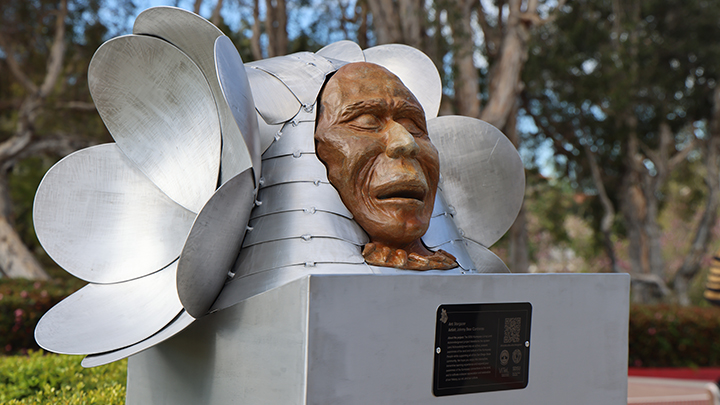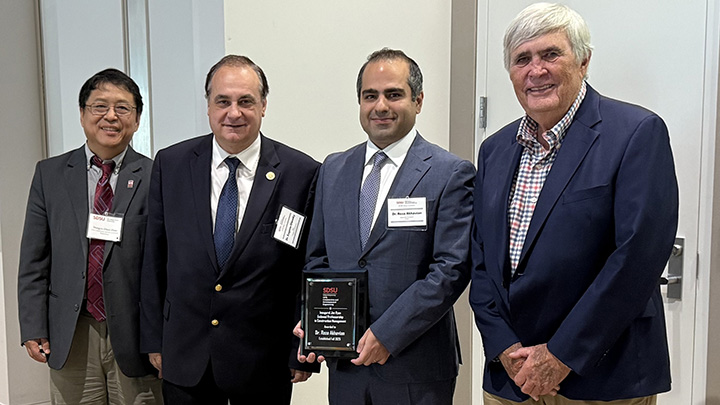Living Land Acknowledgment artwork at SDSU Imperial Valley celebrates new beginnings
“Return of the Kumeyaay Creator,” found in front of the library at SDSU Imperial Valley, Calexico, tells the story of Maayehaa, the Creator God Spirit.

Every piece of art tells a story. A new sculpture installed in the heart of SDSU Imperial Valley, Calexico encapsulates a millennium worth of Kumeyaay tradition and marks the beginning of a mentorship that will bring more Kumeyaay art to the campus.
“Return of the Kumeyaay Creator” stands outside the library entrance in the Rollie Carrillo Quad. The sculpture is part of the Living Land (LLA) series, introduced at SDSU in 2024, which brings life to the university’s Kumeyaay Land Acknowledgment.
Traditionally recited at the all-university convocation, commencement and other major events, the spoken Acknowledgment recognizes Indigenous people as traditional stewards of the land the university now occupies. The living sculpture series aims to foster a deeper understanding of that relationship through art and supplemental virtual reality lessons.
“We are incredibly proud to have this beautiful sculpture on campus. It has rays like the sun that represent our border region throughout the year,” said SDSU Imperial Valley Dean Guillerma Gina Nuñez-Mchiri.
“‘Return of the Kumeyaay Creator’ already is sparking curiosity and conversation on campus,” Nuñez-Mchiri said. “It will be seen by our students, faculty, staff and community. I am excited to see how students who come to campus tours from our local schools in the Valley will engage with the sculpture and how it will help them deepen their understanding and appreciation of the region's relationship with its native people.”
“Return of the Kumeyaay Creator” duplicates the last of three pieces by sculpture series artist Johnny Bear Contreras installed at SDSU last year with the same title, with some subtle shape and color variations. It represents the story of Maayehaa, the Creator God Spirit, who in Kumeyaay culture created the earth. Soon, a plaque with a QR code will be installed on the sculpture, and it will take onlookers to a video of Contreras reflecting on his artistic direction for the piece. Each sculpture is equipped with a unique QR code that recalls an augmented reality, or “living” lesson, tied to Kumeyaay history and culture.
The sculpture also marks the beginning of a mentorship program between Contreras and young artists from different bands of the Kumeyaay tribe represented in Imperial Valley. Contreras and his understudies will work together on additional LLA artwork for SDSU Imperial Valley that will pay homage to the Kamia, Quechan and Cocopah.
“I don’t feel accomplished or finished,” Contreras says in the video. “I feel started. I feel as if I have my feet placed and I am ready for the next iterations.”
Project organizers collaborated with students at the SDSU Native Resource Center to identify high-traffic areas where the artwork could share space with well-known landmarks.
“After thoughtful consideration and collaboration, the project team selected a location in front of the Library — one of the most visible and frequently visited areas on campus,” said Henry Villegas, dean of Student Affairs at SDSU Imperial Valley. “This space is a daily crossroads for students heading to class, faculty meeting with colleagues, and guests and alumni exploring campus.
“Its presence now feels a part of the landscape, a powerful and permanent reminder of the Kumeyaay, Kamia, Quechan and Cocopah people and their enduring legacies.”
SDSU Tribal Liaison Jacob Alvarado Waipuk said: “The Kumeyaay, including Kamia, Quechan, and Cocopah Nations share deep ancestral ties to the Imperial Valley. A place where mountain, desert, and river worlds meet. This sculpture honors those shared homelands and brings our stories to life on campus, as we work together with each Nation to create future pieces that reflect their voices, lands, and living histories.”
The LLA is a collaborative project born from the vision of Stuart Voytilla, a television, film, and new media lecturer and faculty lead for the SDSU Story Lab. Voytilla imagined the project as a way to bring the words of the Land Acknowledgment to life in the physical and virtual spaces, while bringing native artwork to more prominent places at SDSU and SDSU Imperial Valley.
Voytilla said the newest sculpture serves as “a bridge between our San Diego and Imperial Valley communities, and a powerful reminder that our campuses reside on the ancestral lands of Indigenous peoples, whose stewardship continues to this day.
“It’s an honor walking this path with Johnny Bear Contreras,” Voytilla added. “Through art, place, and immersive storytelling, we’re learning how to live the Land Acknowledgment — not just speak it. Eyay e’Hunn. My heart is good.”
Voytilla and the Story Lab came together with the Native Resource Center (NRC), the Virtual Immersive Teaching and Learning (VITaL) Research Center and the Division of Student Affairs and Campus Diversity to turn the idea into reality. The LLA was expanded to SDSU Imperial Valley with help from Megan Jennings, SDSU assistant adjunct ecology professor and principal investigator for the Collaborative of Native Nations for Climate Transformation and Stewardship (CNNCTS), who was instrumental in securing grant funding from the University of Califiornia Climate Action Awards.
About the art
“Stargazer”
The first installation in the Living Land Acknowledgment was “Stargazer,” installed near the Koester Memorial Sundial in front of Hepner Hall. Its focal point is a man’s face angled up at the sky, perfectly positioned to do as its title suggests.
The man’s eyes are closed, expanding his field of vision beyond what is here and now, leaving nothing between him and the stars that have also been present since time immemorial, and will remain far beyond our lifetimes. The man’s state of mind, not in the past, present or future, but in a different place altogether, is an important element of the first piece of the series, according to Contreras.
Attached to “Stargazer” is a QR code that, when scanned, presents an immersive virtual performance of a Kumeyaay bird song by Blue Eagle Vigil and his daughter, Lovely Vigil. Bird songs are a rich and important component of storytelling and legacy keeping in the Kumeyaay culture.

“People of the Sun”
“People of the Sun” came next, about 100 yards away from “Stargazer.” The sculpture stands parallel to a statue of SDSU’s first president, Samuel T. Black, beneath the shade in the North Library Quad. There are two faces, a man and a woman, with delighted expressions emerging from blooming poppies. Their faces are suspended by the stem of the poppy, which grounds them to Mother Earth. The woman’s face is elevated higher than the man’s as an homage to the “life-givers,” Contreras said.
A scan of the second statue’s QR code will initiate an augmented reality experience featuring a recital of the Land Acknowledgment by its author, Mike Connolly Miskwish.

“Return of the Kumeyaay Creator (SDSU)”
“Return of the Kumeyaay Creator” is found in Sickels Plaza along Centennial Walkway, north of the Conrad Prebys Aztec Student Union.
Its QR code takes viewers to a video of Contreras discussing elements of the design, and the creation story that inspired it, from his studio workshop.


